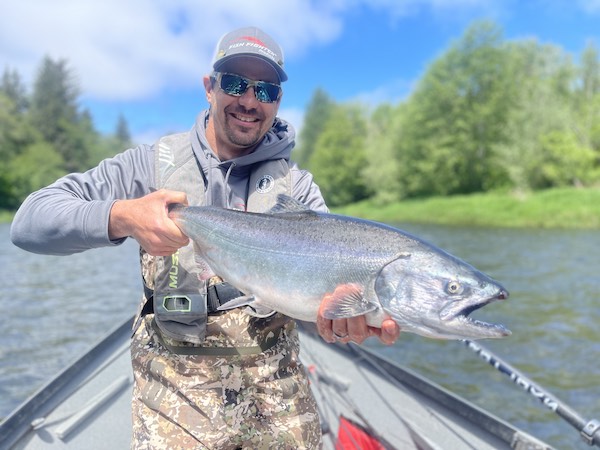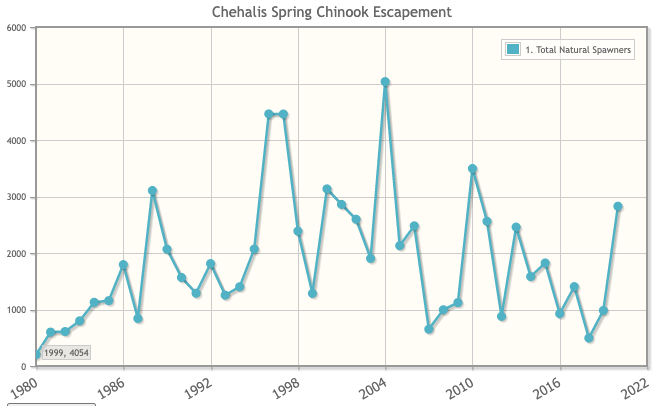Feds Petitioned To List OlyPen, Chehalis Spring Chinook Under ESA
The third petition in a year to list a coastal Northwest salmonid population has been filed with the feds, with two environmental groups calling for Olympic Peninsula and Chehalis River spring Chinook to be placed on the Endangered Species Act list.

“Existing federal and state regulatory mechanisms have proven unable to protect and recover Washington coast spring-run Chinook and their habitat,” conclude the Arizona-based Center for Biological Diversity and Portland’s Pacific Rivers in their 123-page petition to the National Marine Fisheries Service, filed yesterday. “Washington coast spring-run Chinook suffer from chronically low abundance and remain in just a few remnant populations. Spring-run fish have very specific habitat needs, and there are still numerous unaddressed threats to every Washington Coast spring Chinook run and their habitat. Endangered Species Act protection is required to prevent their extinction and implement necessary recovery actions.”
They’re specifically seeking to list springers in the – from south to north – Chehalis, Quinault, Queets, Hoh and Quillayute watersheds, or all spring, summer and fall Chinook runs in those basins, as endangered or threatened.
Currently, they’re all lumped together in a single evolutionarily significant unit, or ESU. In 1998, NMFS found that listing them was not warranted. Sport springer fisheries are typically limited to the Quillayute and its Sol Duc, which hosts a hatchery run.
“Similar to last year’s petition to list coastal steelhead, the Department will be in close contact with NOAA-Fisheries and our Tribal co-managers,” said WDFW Fish Program Director Kelly Cunningham this afternoon. “We will respond to questions and provide data as requested and agreed to with our co-managers.”
This new coastal Chinook petition states that Chehalis wild springer returns annually averaged 1,600 in the 2010s, but the basin “historically” supported as many as 27,000. (WDFW records since 1980 show escapements ranging from as few as 200 in 1980 to 5,034 in 2005.)

CBD and Pacific Rivers also state that returns to the Hoh, Queets and Quinault averaged 1,600 last decade.
They list a raft of problems that will be familiar to those in the fisheries world – “dams, water diversions and migration barriers … habitat degradation due to logging and roads … hatcheries … climate change … ocean commercial and recreational fisheries … increased predation and increases in non-native species such as smallmouth bass …”
The list goes on, but they hope for a turn-around over the coming decades – centuries? – via a listing.
“We need look no further than coho salmon for an ESA success story,” write Pacific Rivers’ Megan Ponder and Don Elder in their organization’s spring quarter newsletter. “Since Oregon’s coastal coho were listed as threatened under the ESA (sic) 1998, coho runs have rebounded impressively and are now on the road to recovery. What we have done in the last quarter century for coho we must now do for spring Chinook.”
As for those two other aforementioned coastal petitions filed over the past 12 months, last August CBD along with Native Fish Society and Umpqua Watersheds requested NMFS list Oregon Coast and far Northern California Chinook, which the feds found may be warranted, launching a year-long deep dive into the status of the stock. (NMFS found listing only springers was not warranted.)
And a petition filed last September by Wild Fish Conservancy and The Conservation Angler on Olympic Peninsula steelhead was accepted earlier this year by NMFS for a 12-month study.
(Asked if pending two- and four-week reductions in the 2023-24 winter steelhead fishery on the Hoh, and Bogachiel, Calawah, Dickey, Quillayute and Sol Duc Rivers was in response to that may-be-warranted finding, Cunningham stated they were instead “based on agreement with comanagers during the North of Falcon process associated with salmon fisheries. For the Hoh this is two weeks earlier than what was listed in the pamphlet last year and 4 weeks earlier for the Quillayute. As you know these regulations also (sic) effect coastal steelhead fisheries in April. If the outcome of steelhead fisheries planning this fall leads to sport fisheries in April, the fisheries could be opened via emergency regulation following agreements with comanagers.”)

